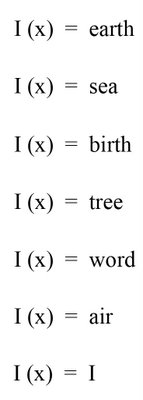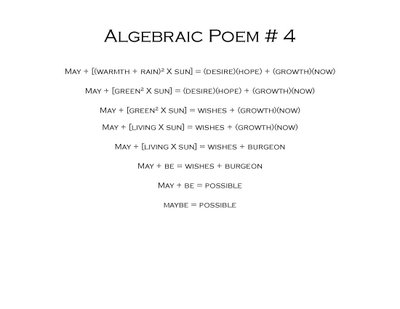Factorial By Scott Glassman

i
am a
quotient of the
sun
i am
a quotient of
the
moon i
am a quotient
of
the one
i am a
quotient
of the
two i am
a
quotient of
the burn i
am
a quotient
of the dew
2.
i
am a
multiple of the
earth
i am
a multiple of
the
sea i
am a multiple
of
the birth
i am a
multiple
of the
tree i am
a
multiple of
the word i
am
a multiple
of the air
3.
i
subtract myself
from you for
luck
i add
myself to you
for
love i
subtract myself from
you
for luck
i add myself
to
you for
love i subtract
myself
from you
for luck i
add
myself to
you for love
4.
i
am zero
over you +
1
i am
zero over you
+
2 minus
0 over you
+
1 minus
0 over you
plus
2 minus
you over me
+
0 minus
1 over you
The poem above is a poem by Scott Glassman called factorial taken from his blog.
I find this poem of Scott Glassman very interesting in that I can see it as an example of mathematical poetry buried inside mathematics poetry. (Click here for the difference between mathematical poetry, mathematics poetry and mathematical visual poetry) The first section of Scott’s poem I have transformed into a piece of mathematical visual poetry. (above) This mathematical visual poem shows four separate mathematical poems that are contained within section one of his mathematics poem.
The verses in the second section have different meanings dependent on whether the poem is lineated or written without lineation. However, both ideas are present in the poem. You can feel the tension between differing statements and the shift in context between the statements due to reading it lineated and then reading it not lineated. I have written out all the mathematical poems/verses I could find contained within this section and displayed them in the image shown above.
The third section functions much the same as the second as far as tension between lineation and reading it without the lineation. However this section has only two statements repeated three times. The interesting part in this section is that the lineation creates two more mathematical poems which are shown in black (above).
The fourth section is a bit more difficult to map out. Therefore I shot a photo of my deductions from the poem. (above) You can see the brackets point to three mathematical poems that are delineated by the brackets inside the mathematics poem. The third one of the three I used algebra to simplify the expression into a compact form/context. Watch the meaning change in this poem through all the metamorphoses.


























